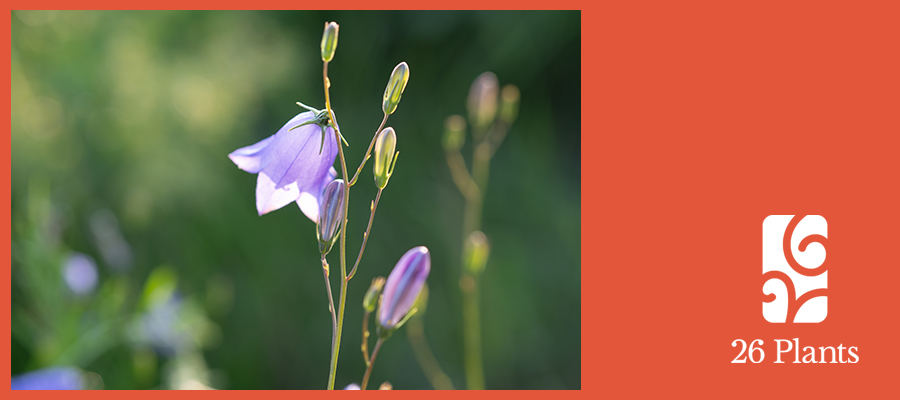Harebell
Campanula rotundifolia
Olivia Sprinkel

Harebell Spell
Petal by petal,
wafer of lace on your tongue,
dissolving melt of bitter lament:
Ingest this spell.
Harebells –
caps made for a fairy’s head,
on body slim as gossamer thread.
Consigned to fringes of our land.
Bounteous where hares and witches fly.
Breaths of summer blue
woven of the same cloth
as the veil of the evening hour.
Slip between worlds:
To where harebells
still dance in silky grass with the caressing breeze,
share soil with the roots of wild strawberries.
Where children
far beyond grown-up grids
trace a map of this flower world,
eat spells petal by petal.
The story of harebells
Harebells. The name rings a bell. I can’t picture them immediately though. I look them up. Blue meadow flowers. Shaped like a bell. Campanula rotundifolia. Also known as witch’s bells, fairy bells or witch’s thimbles.
I’m intrigued by the connection with witches and fairies. This connection is further deepened through the origin of the name harebell. The prosaic reason is that they grew in places frequented by hares. Another reason is that witches used juices squeezed from this flower to transform themselves into hares.
I wanted to see these magical flowers for myself. On the Wildlife Trusts website it said that they are found throughout the UK, and that they flower between July and September.
I mentioned my project to a friend. She said that she had seen them growing in Ditchling Beacon on the South Downs, near to where I live. On a late June evening, I went there, hoping that they might already be in flower, given the warm weather we had been enjoying. There were plenty of other wildflowers in bloom, but no harebells.
I emailed the Sussex Wildlife Trust, who manage Ditchling Beacon, asking if they knew about the harebells. I received a number of helpful replies as the contact there put the word out amongst his colleagues. These included information about when they flower – ‘typically from late July onwards’ – and map co-ordinates.
I decided to wait till end of July and revisit the site then. In the meantime, I travelled to rural eastern Finland to visit my mother. I remembered that I had seen harebells around her house previously. I asked her if there were harebells flowering. ‘Yes, in the garden!’ She pointed out of the window to a patch of blue in the long grass of the lawn. In Finnish, they are known as ‘kissankellot’ or cat’s bells.
Once I had seen them there, I saw them every time I went for a walk – by the sides of the roads, on the fringes of forests. On an island in Helsinki, I happened to look at a foraging book on display, and there was a recipe for harebells, described as ‘bitter, delicious’: ‘harebells, blackcurrants and raw honey’. I picked a flower and placed it on my tongue. It was delicate and bitter. I felt in that moment what we had lost in the UK – the everydayness of these flowers, knowledge of them and their magic.
Image: Photograph by Olivia Sprinkel
